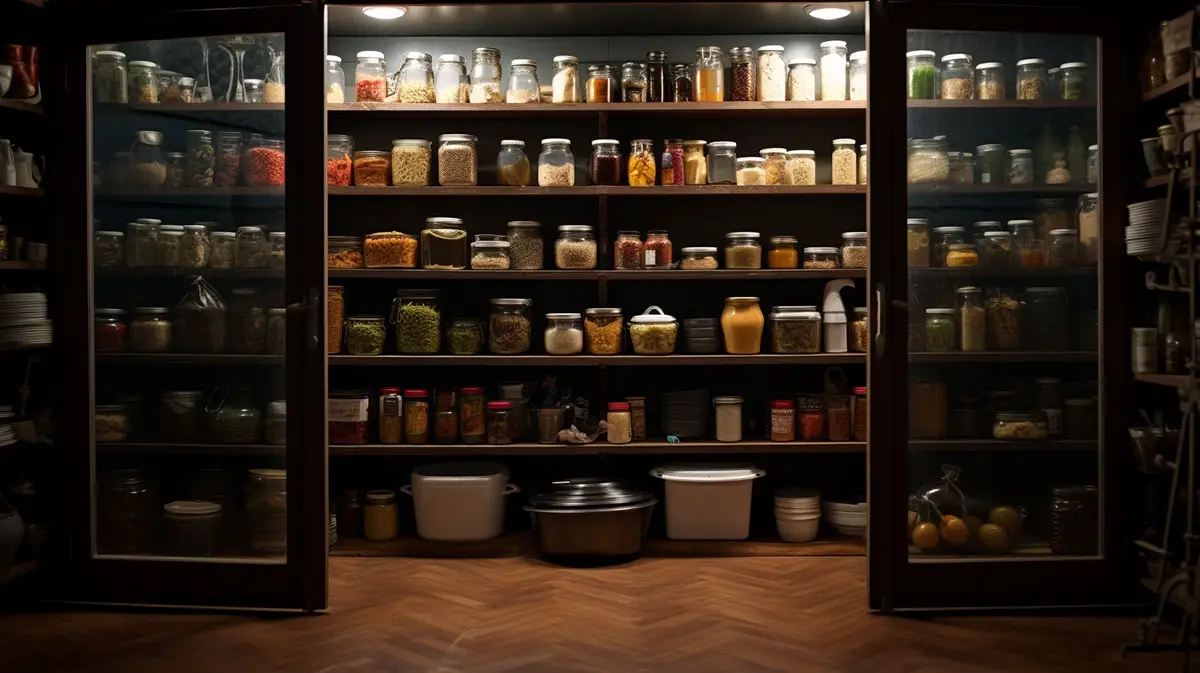378
The year is 2050. America’s once bustling cities are eerily quiet. Supermarkets have been deserted for years. But in your pantry are the foods to stockpile filled decades ago.
What’s up, my preppers? Early in my prepping days I made some mistakes, particularly when it came to food storage. I purchased extra food that I put on a shelf for SHTF, thinking it was a wise move. But a few years later, I found myself discarding most of it. A hard lesson on the importance of strategic planning. Wasted time. Wasted money.
There are two pillars in my food storage strategy now:
- the everyday foods we love and consume regularly, rotating stock to ensure nothing goes to waste, and
- the timeless foods that, once stored, can outlast any crisis.
I will go through some of the critical foods in that latter category, foods that I think YOU should stockpile—today—for a long-term collapse—tomorrow. I call these “set it and forget it” foods because you buy them once, set them on a shelf, and forget it. They’re good for decades. You don’t have to think about it again. This strategy will save you time, money, and give you peace of mind.
I appreciate history, and I rely on it to both provide context for prepping, but also to see what people did in the past, because the biggest threats that we’ll face in a collapse in modern civilization is the collapse of our modern civilization. By that I mean life today is very, very different from life a century or more ago. We rely on technology, just-in-time delivery, and many other fragile, modern systems. When these systems collapse, we’ll be thrown back in time. In order to survive that abrupt adjustment, we must know what people did years ago.
Foods to Stockpile That Do Not Expire
1 – White Rice
Rice has been a staple in many cultures for thousands of years. Ancient civilizations recognized its long-term storage potential. For instance, during the excavation of ancient Korean tombs dating back to the Baekje Period (18 B.C. to A.D. 660), archaeologists discovered rice stored in bronze bowls that was estimated to be around 1,400 years old. Although not fit for consumption after such a lengthy period, the preservation of the grains in a recognizable form underscores rice’s durability.

White rice is a staple in food storage for many preppers and with good reason. It’s a versatile, high-calorie food that serves as an excellent source of energy. Additionally, its relatively low cost and wide availability make it an accessible option for bulk storage. With the correct storage methods, white rice has the potential to last for decades, ensuring that you have a reliable food source in prolonged crisis situations.
Why white rice over brown rice? There are a few reasons:
1. Shelf Life:
White rice has a longer shelf life. While both types of rice originate from the same grain, brown rice retains its bran layer, white does not. The bran layer contains oils that can go rancid over time. White rice, on the other hand, has had this layer removed, which greatly extends its storage potential. Properly stored white rice can last up to 30 years, while brown rice typically has a shelf life of only 3 to 6 months, though this can be extended up to a year if stored under ideal conditions.
2. Nutritional Differences:
Brown rice is more nutritious, however. It contains more fiber, vitamins, and minerals. Still, white rice is calorie-dense and provides essential energy. A cup of white rice provides around 200 calories, primarily from carbohydrates. The loss of some nutrients in white rice compared to brown can be compensated for by pairing it with other food sources, which I’ll get to in a moment.
3. Cooking Time and Fuel Efficiency:
Brown rice typically takes longer to cook than white rice. In a survival scenario, conserving fuel may become essential. The longer cooking time for brown rice means more fuel consumption. White rice can be a more fuel-efficient choice.
4. Taste and Versatility:
Another advantage of white rice is that it has a more neutral flavor, making it a versatile food staple. It can be easily paired with various dishes, spices, and sauces. Brown rice has a nuttier taste, which might not be as universally preferred, especially over extended periods.
5. Digestibility:
The bran layer in brown rice, while nutritious, can also be harder for some people to digest, especially if they’re not used to eating it regularly. In a crisis scenario, dealing with digestive pain can be problematic, making the easier-to-digest white rice a safer choice for a broader range of people.
Storage
Now, let’s pause for a moment to briefly cover storage of white rice. What applies to white rice will apply to other items in this list. I’m not going to spend a lot of time on it because many of you mid to long-term preppers are probably already aware of this.
I go into this process in detail on my Storing Rice Long-Term article, but it generally goes like this:
First order of business is buying some Mylar bags with Oxygen absorbers. Pour the rice in a Mylar bag. Add the correct number of oxygen absorbers. Seal it up with an iron. Let the O2 absorbers do their work. Put the bag in a food-grade bucket to protect it from vermin and so you can more easily stack it and carry it. Grab a Gamma seal lid if you want to have easy access to the bucket for taking food out.
I go into more detail on this storage strategy in my video on How to Store Wheat Berries.
2 – Dried Beans
Dried beans have been a food staple for millennia. From ancient Egyptian tombs to the storehouses of the Mayans, beans have been found stored away for future use. In 2008, archaeologists unearthed a 1,500-year-old stash of beans in New Mexico, which belonged to the ancient Pueblo Indians. Beans were one of the staples of Pueblo Indians. The beans’ resilience and significance in ancient diets highlight their importance as a reliable food source.

Now there’s a reason I’m following rice with dried beans.
When preparing for long-term survival, optimizing nutrient intake is crucial. Remember I said white rice, while less nutritious than brown rice, is great to pair with other foods? Well, here we are.
Separately, rice and beans are nutritional powerhouses. But when combined, they offer 6 important benefits:
1. Complete Protein Source:
Each contains essential amino acids that the other lacks. Beans are rich in lysine (lie-seen), while rice provides methionine. When you consume them together, they form a complete protein. This means they offer all the essential amino acids our bodies need but can’t produce on their own. Complete proteins are typically found in animal products, so having a plant-based source is especially beneficial for vegetarians or in situations where meat becomes scarce.
2. Sustained Energy:
The carbohydrates in rice provide immediate energy, while the protein and fiber in beans give a slower, more sustained energy release. This combination can help keep energy levels stable, which is vital in a survival situation where consistent energy may be needed for tasks like building shelter, sourcing water, or protecting yourself.
3. Digestive Health:
Beans are a rich source of dietary fiber, particularly soluble fiber, which can help lower blood cholesterol levels and stabilize blood sugar. Rice acts as a binder, aiding in digestion and preventing diarrhea, a potential lifesaver in situations without access to medical care.
4. Cost-Effective and Filling:
From a prepper’s perspective, both rice and beans are relatively cheap to procure in bulk. Additionally, meals made from this combo are incredibly filling, meaning you need less to feel full, extending your food stores further.
5. Versatility in Meals:
Rice and beans can be the base of countless dishes. By adding a few spices or additional ingredients, you can create a wide variety of meals, preventing palate fatigue, which is essential for maintaining morale during challenging times.
6. Micronutrients:
While rice provides essential energy, beans contribute a host of vitamins and minerals, including iron, magnesium, potassium, folate, and more. This combination helps ensure you’re getting a broad spectrum of micronutrients, which can support everything from immune function to nerve signaling.
Different beans bring slightly varied nutritional profiles:
- Black Beans are high in antioxidants, they can be great for digestive health.
- Kidney Beans are known for their richness in iron and healthy fats.
- Chickpeas (Garbanzo Beans) are solid source of both protein and fiber.
In terms of meal preparation, beans can be used in soups, stews, salads, or even ground to make patties. The variety of beans ensures that one doesn’t tire from a monotonous diet.
Follow the same storage advice I gave you for white rice.
But does rice and beans day after day sound dull? Of course it does. That’s why you add…
3 – Salt
Did you know Roman soldiers were sometimes paid in salt? That’s where the word “salary” comes from. Their monthly allowance was called “salarium” (“sal” being the Latin word for salt). Actually, that’s what salt is in Spanish as well. Anyway, it was a highly valued commodity due to its uses in food preservation and flavoring.

In medieval Europe, salt was crucial for preserving fish, especially cod from the North Atlantic, which was consumed widely across Europe. This made cities with salt production capabilities very prosperous.
Sherpa Pink Himalayan Salt 25 lb. Coarse Bulk Bag – Ideal for Salt Grinders & Salt Mills
- 100% NATURAL PINK & CERTIFIED: Our Sherpa Pink Himalayan Salt is is Kosher Certified, Non-GMO, and does not contain any MSG, Soy, Gluten, Dairy, or anti-caking agents. We import ONLY the highest quality food grade Himalayan salts and package in our U.S.A., SQF Quality code, Organic compliant facility.
- GRINDER READY COARSE GRAIN: Our Coarse Grain Sherpa Pink Himalayan Salt must be ground before consumption.
1. Why Preppers Should Store It:
- Preservation: Historically, salt has been a primary method for preserving foods. It inhibits the growth of microorganisms by drawing water out of microbial cells through osmosis. Salt can be used again after modern refrigeration ends.
- Nutritional Need: Our bodies require a certain amount of sodium to function. Sodium helps maintain fluid balance, transmit nerve impulses, and is involved in muscle contractions.
- Multiple Uses: Beyond its culinary uses, salt can be used for various purposes such as cleaning, first aid, and even as a bartering item in a post-collapse economy.
- Easy of Storage: Salt is very easy to store.
2. What It Offers in Terms of Meal Preparation and Nutrients:
- Flavor Enhancer: Salt is a universal seasoning. It has the ability to elevate the flavors of many foods, making meals more palatable.
- Mineral Source: While the primary mineral in table salt is sodium, natural forms of salt, like Himalayan pink salt, can contain up to 84 different trace minerals.
- Curing: Salt can be used to cure meats, a process which not only flavors the meat but also helps to preserve it.
4 –Wheat Berries
Back to wheat berries. Throughout history, grains like wheat berries have been a staple in human diets. Ancient civilizations, like the Egyptians and Romans, relied heavily on wheat as a primary food source. Notably, the Egyptians were known to store wheat for years to ensure food security during times of famine or crop failures.

Wheat berries are the whole grain form of wheat, the tiny kernels that grow up to become flour. These small but mighty kernels hold a prominent place in the prepper’s pantry, and here’s why:
- Why Preppers Should Store Wheat Berries:
- Unlike flour, which is typically designated for one purpose (baking), wheat berries can be cooked and eaten as is, ground into flour, sprouted, or even planted to grow more wheat.
- When stored correctly wheat berries have a wild shelf life, allowing you to keep a robust and nutritious food source on hand for years.
- They’re exceptionally easy to store. Read my article on How to Store Wheat Berries for more information.
- Nutrition and Meal Preparation:
- Wheat berries are packed with fiber, protein, and iron. They’re also a great source of B vitamins, which are essential for energy and metabolism.
- They can be used in a variety of dishes, from hearty stews and salads to cereals and desserts. When ground, they become whole wheat flour, perfect for bread and other baked goods.
Processing Wheat Berries into Flour Off-Grid:
Turning wheat berries into flour without modern conveniences might seem daunting, but our ancestors have done it for millennia. Here’s how you can too:
- Mortar and Pestle: The most ancient method. Place small amounts of wheat berries in the mortar and grind them with the pestle until you get a fine powder. This method is labor-intensive but requires minimal equipment.
- Hand Grain Mill: A more efficient tool than the mortar and pestle, hand-cranked grain mills are specifically designed to turn grains into flour. They come in various sizes and can be adjusted to produce either coarse or fine flour.
- Stone Grinding: If you can find two large flat stones, you can use the traditional method of stone grinding. Place wheat berries between the stones and grind in a circular motion. This produces whole grain flour that retains all its nutrients.
When considering off-grid flour production, it’s crucial to remember that freshly milled flour will still contain all its natural oils. This means it won’t have the same shelf life as store-bought flour and should be used relatively quickly to avoid rancidity.
Go see my video on how to store wheat berries for more information. Do that and they can remain fresh and edible for 30 years or more.
5 – Sugar
Sugar, particularly in the form of honey and later cane sugar, was a valuable commodity in ancient civilizations like Egypt and India. It was used both as a sweetener and in medicinal concoctions. It’s also easy to store sugar long-term.

The demand for sugar, produced primarily in the Caribbean plantations, drove European exploration and trade in the 16th and 17th centuries. It was a luxury item and was stored for extended periods by the elite.
1. Why Preppers Should Store It:
- Preservation: Sugar acts as a preservative, making it essential for canning and preserving fruits. It prevents the growth of harmful microorganisms, thus extending the shelf life of many foods.
- Energy Source: Sugar is a quick energy source. While it should be consumed in moderation, during strenuous survival situations, a boost of energy from sugar can be beneficial.
- Taste and Morale: In challenging times, having sweetened foods can provide a psychological boost, improving morale and mental well-being.
2. What It Offers in Terms of Meal Preparation and Nutrients:
- Versatility: Beyond sweetening, sugar can be used in baking, cooking, and beverage preparation. It’s a foundational ingredient in many recipes.
- Caloric Value: While sugar doesn’t offer vitamins or minerals, it does provide calories, which can be crucial in survival scenarios where caloric intake becomes paramount.
Plain white sugar, the kind you’ll want to store, has an indefinite shelf life because it doesn’t support microbial growth. It doesn’t have the minerals and moisture that other types have. The only way it becomes unusable is if it becomes exposed to water. So keep it stored in a cool, dark, dry place in something like jars or food grade buckets.
Even if sugar changes its texture or appearance, it doesn’t mean it has gone bad. Just protect it from moisture and pests, and it will be a reliable sweetener and preservative for the long haul.
6 – Powdered Milk
Powdered milk has its roots in the early 20th century when it was developed as a way to preserve and transport milk more efficiently. During World War II, it became a staple for soldiers due to its portability and shelf life. Today, many cultures and regions where refrigeration is limited still rely heavily on powdered milk as a primary source of dairy.

Milk, being a perishable item, isn’t typically associated with long-term storage. However, when transformed into its powdered form, milk becomes a prepper’s ally.
Why Preppers Should Store Powdered Milk:
- Extended Shelf Life: Unlike fresh milk, which spoils quickly, powdered milk can last for years when stored correctly.
- Versatility: It can be reconstituted into liquid milk or added directly to recipes that require milk.
- Space Efficiency: Being dehydrated, powdered milk occupies less space compared to its liquid counterpart.
Nutrition and Meal Preparation:
- Nutrient-Rich: Powdered milk retains most of the essential nutrients found in fresh milk, including calcium, vitamin D, and protein.
- Culinary Uses: Beyond just reconstituting it to drink, powdered milk can be used in baking, making sauces, soups, and even yogurt and cheese, if you have the know-how.
For the longest-term storage, store it using Mylar bags and oxygen absorbers as I already described.
Shelf Life of Powdered Milk:
When stored properly, powdered milk can remain fresh and nutritious for 20 years or more. However, for optimal taste and nutritional value, it’s best to consume it within 2-10 years, depending on the specific brand and storage conditions.
7 – Hard Liquor
Throughout history, alcohol has been a consistent companion to humans. From the ancient Egyptians using beer for medicinal and ritual purposes to sailors in the 18th century being rationed rum to boost morale and combat scurvy, its importance is undeniable. Moreover, during the Prohibition era in the U.S. (1920-1933), the value of alcohol skyrocketed, turning it into a prime bartering commodity.

When it comes to prepping, hard liquor might not be the first item that springs to mind. However, its multifaceted uses and enduring nature make it a noteworthy addition to any prepper’s storage.
Why Preppers Should Store Hard Liquor:
- Longevity: Spirits like vodka, whiskey, rum, and tequila have an indefinite shelf life, thanks to their high alcohol content.
- Multipurpose Utility: Beyond mere consumption, hard liquor can serve various roles in a crisis, from antiseptic to barter item.
- Morale Booster: In times of stress and uncertainty, having a small luxury like a sip of whiskey can provide a psychological lift.
Benefits and Usage:
- Medicinal: Alcohol can disinfect wounds, act as a pain reliever in moderation, and even be used in homemade tinctures and remedies.
- Preservation: Hard liquor can be used to create extracts (like vanilla) and preserve certain foods or herbs.
- Fire Starter: The high alcohol content makes it a potential fire starter in emergency situations.
- Bartering Tool: In a prolonged crisis scenario, items like alcohol might become highly sought-after commodities.
Best Types of Hard Liquor for Long-Term Storage:
The type of hard liquor you choose to store can impact its utility in various scenarios. While most spirits have an indefinite shelf life, those with higher alcohol content tend to be more versatile. Here are some top choices:

- Everclear or Grain Alcohol:
- Alcohol Content: Ranges from 75.5% to 95% alcohol by volume (ABV).
- Uses: Due to its extremely high alcohol content, it’s perfect for disinfection and medical purposes. It can also be diluted with water to make other spirits or used in homemade extracts.
- Note: Consumption should be done with caution due to its high potency.
- Vodka:
- Alcohol Content: Typically around 40% ABV, though some brands offer higher percentages.
- Uses: Its neutral flavor makes it versatile for both consumption and other uses, like cleaning, disinfection, and as a base for tinctures.
- Whiskey/Bourbon:
- Alcohol Content: Usually between 40% to 50% ABV.
- Uses: Apart from consumption, whiskey can be used for medicinal purposes, such as a pain reliever or for wound cleaning in a pinch.
- Rum:
- Alcohol Content: Generally around 40% ABV, but overproof rums can reach up to 75% ABV.
- Uses: Beyond its flavor profile for consumption, high-proof rum can be used like to vodka and whiskey for various applications.
- Tequila:
- Alcohol Content: Standard tequilas hover around 40% ABV.
- Uses: Its distinct flavor can add variety to a prepper’s palate, and it can be utilized for some medicinal and disinfectant purposes.
- Gin:
- Alcohol Content: Generally around 37.5% to 50% ABV.
- Uses: Apart from its unique flavor derived from botanicals, gin can serve as a disinfectant and base for some herbal tinctures.
Storage Tips:
- Upright Storage: Unlike wine, which benefits from being stored on its side, hard liquor should be stored upright to prevent the alcohol from degrading the cork.
- Cool, Dark Place: While hard liquor has a stable shelf life, it’s still best to store it away from direct sunlight and in a consistently cool environment to maintain its quality.
- Sealed Tight: Ensure that the bottle is tightly sealed to prevent evaporation and maintain the integrity of the spirit.
8 – Lentils
Lentils have been a staple in human diets for thousands of years. Archaeological evidence shows lentils were eaten 13,000 to 9,500 years ago in the area of present-day Greece and Bulgaria. Their long-standing place in human history speaks volumes about their nutritional value and storability.

Why Preppers Should Store Lentils: Lentils, as part of the legume family, offer a tremendous bang for the buck when it comes to prepping. They are compact, lightweight, and easy to store. Moreover, they offer a great return on investment in terms of nutrition and calories for the space they occupy in your pantry. Given their high protein content, they are especially important for those who might not have access to fresh meat in a crisis.
Nutritional Value & Meal Preparation: Lentils are incredibly nutritious. They are a rich source of essential proteins, fiber, folate, and several important minerals like iron, manganese, and phosphorous. A single cup of cooked lentils provides about 18 grams of protein. Lentils are also versatile in terms of meal preparation. They can be made into soups, stews, salads, or even ground to be used as a meat substitute in various dishes.
9 – Dried Corn
The cultivation and use of corn date back to ancient civilizations in the Americas. Native American tribes relied heavily on corn, preserving it as dried kernels for use throughout the year. This method of food preservation was essential for survival during harsh winters and times of scarcity.

Dried Corn: A Timeless Staple
Why Preppers Should Store Dried Corn: Given its dense caloric content, ease of storage, and versatility in meal preparation, dried corn provides sustenance and diversity to the diet in emergency scenarios. When properly stored, it offers an impressive shelf-life, ensuring a reliable food source over extended periods.
Nutritional Value & Meal Preparation: Rich in dietary fiber, vitamins, and minerals, dried corn is especially notable for its B-vitamin content, magnesium, and antioxidants. When rehydrated and cooked, dried corn can be incorporated into a multitude of dishes — from soups and stews to bread and casseroles. Ground into cornmeal, it serves as the base for many traditional recipes like cornbread, polenta, and tamales.
For the longest shelf-life possible, follow the same Mylar bag and oxygen absorber directions. As you can figure out, you’ll need a lot of Mylar bags and O2 absorbers. Again, links to these products in the description. Do it right the first time. Set it and forget it.
10 – Vinegar
The use of vinegar dates back thousands of years. Ancient civilizations, including the Egyptians and the Greeks, recognized its medicinal properties. In fact, Hippocrates, often referred to as the father of modern medicine, was known to use vinegar to treat wounds and other ailments.

- Preservation: Vinegar is well-known for its preservative qualities. It’s acidic, which means it inhibits the growth of bacteria and can be used for pickling vegetables. This allows for the long-term storage of perishable food items without the need for refrigeration.
- Versatility in Cooking: Vinegar can be used to prepare a variety of dishes, adding flavor to soups, salads, and marinades. It’s an essential ingredient in many recipes, and its acidity can help tenderize meats and bring out other flavors in food.
- Health Benefits: Vinegar, particularly apple cider vinegar, is often touted for its potential health benefits. It contains acetic acid, which has been studied for its effects on blood sugar levels, cholesterol, and even weight management. Some people also use vinegar as a home remedy for ailments ranging from sore throats to skin irritations. It can serve as a digestive aid, help to relieve insect bites and stings, and has antifungal and antibacterial properties.
- Cleaning and Disinfecting: Beyond its culinary uses, vinegar is an excellent natural cleaner. It can be used to clean surfaces, disinfect items, and even purify water in some emergency situations. It’s a safer alternative to chemical disinfectants and is non-toxic.
- Weed Control: In a situation where traditional weed killers are not available, vinegar can serve as an effective organic herbicide. It’s a non-toxic way to control unwanted vegetation around living spaces or in a survival garden.
- Shelf Life: Vinegar has an almost indefinite shelf life. The acidic nature of vinegar makes it self-preserving. Over time, some types of vinegar may change in appearance and develop a cloudy look, often referred to as “mother of vinegar,” which is a natural byproduct of the vinegar bacteria and is non-toxic. This does not mean the vinegar has gone bad, and it can still be used.
- Best Way to Store Vinegar: Vinegar should be stored in a cool, dark place away from direct sunlight. The original packaging is typically suitable for long-term storage, especially if it’s glass. Plastic containers can also work, but they may not be ideal for storage beyond a few years as the plastic can degrade and potentially leach into the vinegar. Ensure the lid is tightly sealed to prevent the evaporation of the vinegar. If you’re using metal caps, be aware that vinegar can corrode metal, so it’s generally better to use plastic or coated caps for long-term storage.
11 – Coconut Oil
In many tropical regions, coconut oil has been a dietary staple for centuries. Pacific Islander communities, for instance, have thrived on diets high in coconut products, showcasing the oil’s sustenance capabilities.

Why Preppers Should Store Coconut Oil: Coconut oil’s unique combination of fatty acids has earned it a prized spot among health enthusiasts and chefs alike. But for preppers, its appeal extends beyond the kitchen. Coconut oil boasts a long shelf-life, multi-functionality, and dense caloric content, making it an essential item for long-term storage and survival scenarios.
The Dietary Importance of Fats in Long-Term Storage: Fats are a dietary cornerstone, serving multiple roles:
- Energy: Fats are the most calorie-dense macronutrient, offering 9 calories per gram, making them a vital energy source, especially during periods of scarcity or high physical demand.
- Vitamin Absorption: Certain essential vitamins like A, D, E, and K are fat-soluble, meaning they require fats for absorption and storage within the body.
- Brain Health: Fats, particularly the types found in coconut oil, are essential for brain function. The brain itself is made up of nearly 60% fat.
- Temperature Regulation: Fats act as insulators, helping maintain body temperature in cold environments.
Why Coconut Oil Stands Out for Long-Term Storage:
- Shelf Stability: While many oils, like canola or olive, can go rancid relatively quickly, coconut oil has a high saturated fat content, which gives it a longer shelf-life. Saturated fats are less reactive than unsaturated fats, making them less prone to oxidation and spoilage.
- High Smoke Point: Coconut oil can withstand higher cooking temperatures without breaking down, unlike some other oils.
- Antimicrobial Properties: The medium-chain fatty acids in coconut oil, particularly lauric acid, have natural antimicrobial properties, which can help in preventing spoilage.
- Solid at Room Temperature: Unlike many other oils that remain liquid, coconut oil’s solid state at room temperature can prevent leakage and potential contamination.
Furthermore, it can be consumed directly for an energy boost or added to beverages like coffee for a creamy texture.
Storing Coconut Oil for the Longest Shelf-Life: Coconut oil remains solid at room temperature, which aids in its long storage life. To maximize its shelf-life, it’s best to store coconut oil in a cool, dark place in an airtight container.
Note that you want to stock virgin or extra-virgin coconut oil, also called unrefined coconut oil. It’s made from fresh coconut meat, or copra. It has a shelf life of up to five years. That’s not forever, but it’s remarkable for fats. Refined coconut oil is made with dried coconut flesh.
That will keep for up to eighteen months. So, remember, like Madonna, like a virgin, extra virgin.
12 – Instant Coffee
During World War II, instant coffee gained immense popularity among American soldiers. It was included in their ration kits, allowing them to have a quick energy boost wherever they were. The army’s reliance on this beverage showcased its practicality and ease of use in challenging conditions.

- Why Preppers Should Store Instant Coffee:
- Morale Boost: In challenging scenarios, a familiar taste can elevate spirits and provide comfort. A simple cup of coffee can act as a reminder of better days and serve as a touch of normalcy amidst chaos.
- Energy and Alertness: The caffeine in coffee helps increase alertness and reduce the perception of fatigue. In survival situations, staying alert and awake can be critical.
- Compact and Lightweight: Unlike traditional coffee beans or grounds, instant coffee is highly concentrated, so you can store a large number of servings in a small space.
- Quick Preparation: No need for a coffee maker or filters. Just add hot water, and you’re good to go.
Little known fact is that instant coffee—in most cases—is actually freeze-dried. This gives it a shelf-life of AT LEAST a few decades. My personal favorite is Franklin’s. It’s made for preppers with a 25-year shelf life. It’s a quick and easy way to stock coffee. Great for camping. Great for the apocalypse. Tastes better than you’d expect. Link in the description.
Store it in a cool, dry place and otherwise follow my directions on How to Store Coffee Long-term.
13 – Honey
Archaeologists have discovered pots of honey in ancient Egyptian tombs that are over 3,000 years old and yet still perfectly preserved. This ancient delicacy attests to honey’s incredible shelf life and its value in ancient civilizations, not just as a food but also for its medicinal properties.

Why Preppers Should Store Honey:
- Natural Preservative: Due to its low water content, high acidity, and the presence of hydrogen peroxide, honey naturally resists bacteria and spoilage, making it a perfect item for long-term storage.
- Health Benefits: Beyond its sweet taste, honey has been recognized for its antimicrobial properties and has been used as a remedy for various ailments throughout history. It can soothe a sore throat, act as a cough suppressant, and promote wound healing.
- Versatile Use: Honey isn’t just for tea or toast. It’s a flexible ingredient in cooking, useful for sweetening dishes, baking, and even for making mead (honey wine).
What Honey Offers:
- Energy Boost: Honey is a natural source of carbohydrates, providing a quick energy boost when needed.
- Rich in Antioxidants: Contains a variety of beneficial compounds like flavonoids and phenolic acids which have antioxidant properties.
- Digestive Aid: Honey can help with digestive issues, acting as a prebiotic by promoting the growth of beneficial gut bacteria.
Raw and Unfiltered Honey
While all honey offers valuable benefits, raw and unfiltered honey is what you want to store. It stands out as the superior choice for several reasons:
- Packed with Nutrients: Raw honey has not been heated or pasteurized, preserving all the beneficial enzymes, vitamins, and minerals.
- Contains Pollen: Being unfiltered, raw honey contains bee pollen, which has been linked to numerous health benefits, including boosting the immune system, reducing inflammation, and improving liver function.
- Natural Texture: Raw and unfiltered honey tends to have a creamier and more consistent texture. This is due to the presence of natural bee wax and other beneficial compounds that might be filtered out in processed versions.
- Taste: Many enthusiasts claim that raw honey has a richer, more robust flavor profile compared to its processed counterpart.
Storage Tips for the Longest Shelf-Life:
- Cool and Dry: Store honey in a cool, dry place away from direct sunlight.
- Tightly Sealed: Ensure the container’s lid is securely fastened to prevent moisture and contaminants.
- Crystallization: Over time, honey might crystallize, turning from a liquid to a more solid state. This is a natural process and does not indicate spoilage. To return it to its liquid form, simply place the container in warm water.
- Avoid Metal Containers: Metal can react with the acidity in honey. Instead, opt for glass jars or food-grade plastic containers.
- Away from Fermentables: If you’re storing honey alongside other items like grains or yeast, make sure the honey is well-sealed to prevent any potential cross-contamination that could lead to fermentation.
14 – Baking Soda
Baking soda, believe it or not, has been used for centuries. It’s just sodium bicarbonate. Ancient Egyptians utilized natural deposits of it as a soap-like cleaning agent. Its modern production began in the late 18th and early 19th centuries, and since then, it has been a staple in households around the world.

Why Preppers Should Store Baking Soda: Baking soda is a must-have for every prepper because of its multifunctional nature. Not only is it an essential ingredient in many recipes, but it also has a plethora of uses ranging from cleaning to personal care and even medicinal purposes. Its versatility makes it one of the best items to have on hand in a long-term crisis scenario.
Uses and Benefits:
- Cooking: At its core, baking soda is a leavening agent, making it essential for many baked goods. It helps dough rise by producing carbon dioxide when combined with an acid.
- Cleaning: Baking soda acts as a gentle abrasive, perfect for cleaning surfaces without scratching. It also neutralizes odors, making it a great deodorizer for fridges, shoes, and carpets.
- Personal Care: It can be used as a toothpaste alternative, a deodorant, and even in baths to soothe skin irritations.
- Medicinal Uses: Baking soda can neutralize stomach acid, offering relief from heartburn and indigestion. Baking soda and water paste can also alleviate the pain from insect bites and stings.
How to Store Baking Soda Properly for the Longest Shelf-Life:
- Original Packaging: If unopened, baking soda can be stored in its original packaging.
- Airtight Container: Once opened, transfer baking soda to an airtight container to prevent it from absorbing odors and moisture from the air.
- Cool, Dry Place: Store away from heat sources and humidity. A pantry or a basement is ideal.
- Check for Efficacy: Baking soda loses its potency over time. A simple test is to drop a spoonful into a glass of vinegar. If it fizzes vigorously, it’s still active. If not, it may still be used for cleaning, but not for baking.
15 – Freeze Dried Foods
Last but not least, freeze-dried foods. I saved this for last, because while great, it’s also the most expensive product I’ve listed here.

While freeze-drying may seem like a modern marvel, the Incas of the Andes were using an early form of the technique. They stored their potato harvest in high-altitude areas, where the crops would naturally freeze, and daytime sun would aid in the drying process. Today, freeze-drying is used not only for prepping but also in the space program. Astronauts have been consuming freeze-dried foods since the early days of space exploration.
The best way to buy freeze-dried foods is through bulk sale discounts!
Why Preppers Should Store Freeze-Dried Foods: Freeze-dried foods are a game changer in the world of long-term food storage. The process of freeze-drying retains the nutritional content of the food while removing moisture, leading to an extended shelf life without the need for preservatives. With an array of options from fruits, vegetables, meats, and even full meals, freeze-dried foods can provide a balanced diet in crisis situations.
What Freeze-Dried Foods Offer in Terms of Meal Preparation and Nutrients:
- Diverse Menu: From strawberries to beef stroganoff, the variety of freeze-dried foods available means you don’t have to compromise on a diverse diet.
- Quick Preparation: Most freeze-dried foods simply require the addition of water, and within minutes, you have a meal ready. This is especially useful in situations where time and resources are scarce.
- Lightweight: Without the water content, these foods are light, making them perfect for bug-out bags or mobile scenarios.
How to Store Freeze-Dried Foods Properly for the Longest Shelf-Life:
- Unopened Packages: Most commercial freeze-dried foods come in vacuum-sealed packages and, if unopened, can last up to 25-30 years.
- Protection from Light and Heat: Store in a cool, dark place. Exposure to sunlight and heat can reduce the shelf life.
- Oxygen Absorbers: If repackaging or once a package is opened, use oxygen absorbers to extend shelf life and maintain freshness.
- Airtight Containers: After opening, transfer any unused portions to an airtight container to prevent moisture absorption.
Summary
One thing to stay mindful of throughout this video is that some foods will require water. Rice needs water to cook, and other foods will I mention will as well. Plan water accordingly.
The lessons of history and the challenges of our ever-evolving world emphasize one clear message: preparation is paramount. Every item you store today is an investment in your future and the well-being of those you love.
Remember, the future is uncertain, but with the right preparations, our resilience is limitless. Subscribe, stay informed, and let’s keep prepping! What that I listed do you stock? What did I miss? Let me know in the comments section.


















